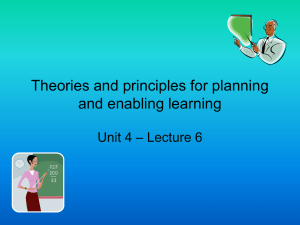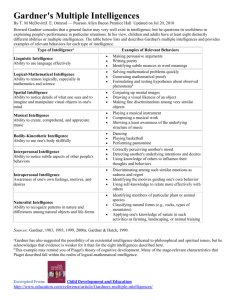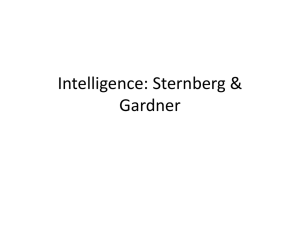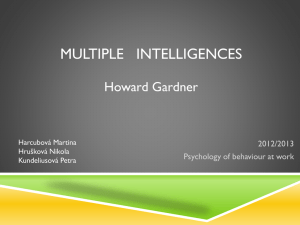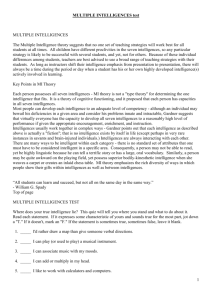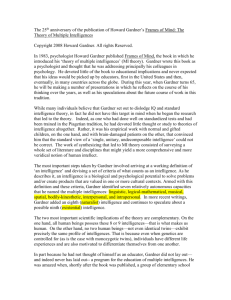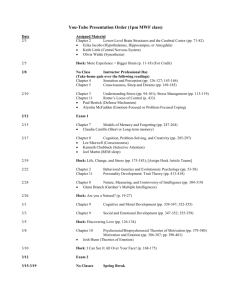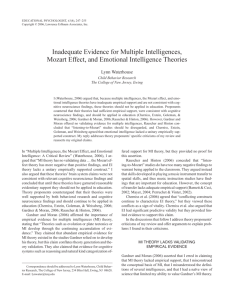Gardner`s Theory of Multiple Intelligences (MI) proposes that the
advertisement
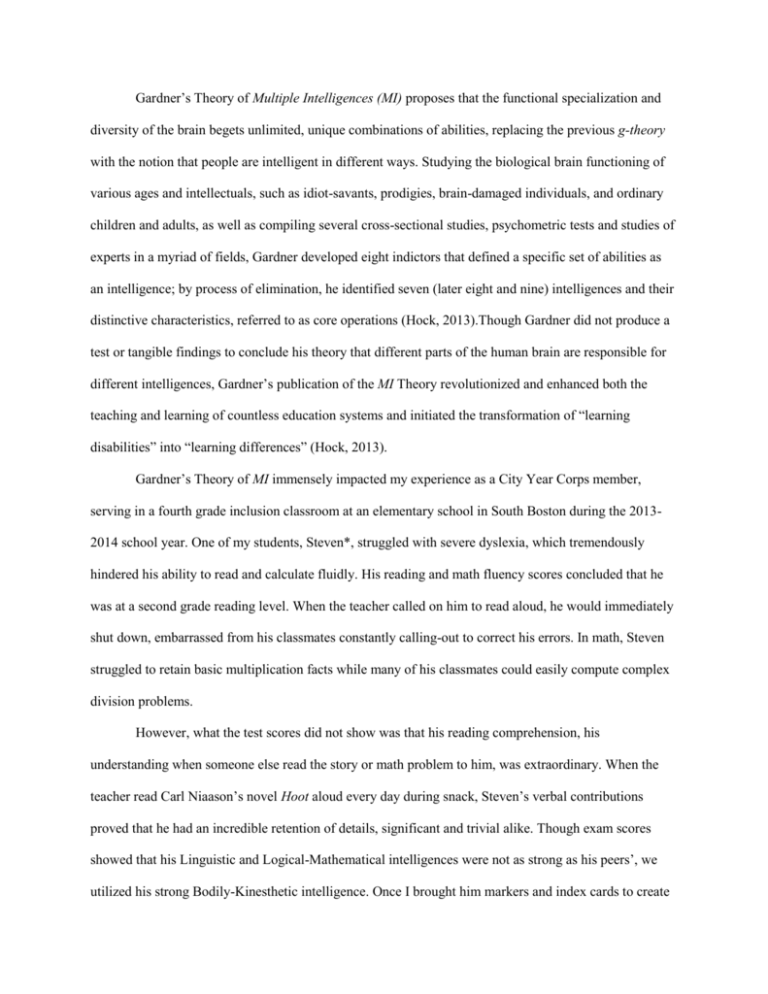
Gardner’s Theory of Multiple Intelligences (MI) proposes that the functional specialization and diversity of the brain begets unlimited, unique combinations of abilities, replacing the previous g-theory with the notion that people are intelligent in different ways. Studying the biological brain functioning of various ages and intellectuals, such as idiot-savants, prodigies, brain-damaged individuals, and ordinary children and adults, as well as compiling several cross-sectional studies, psychometric tests and studies of experts in a myriad of fields, Gardner developed eight indictors that defined a specific set of abilities as an intelligence; by process of elimination, he identified seven (later eight and nine) intelligences and their distinctive characteristics, referred to as core operations (Hock, 2013).Though Gardner did not produce a test or tangible findings to conclude his theory that different parts of the human brain are responsible for different intelligences, Gardner’s publication of the MI Theory revolutionized and enhanced both the teaching and learning of countless education systems and initiated the transformation of “learning disabilities” into “learning differences” (Hock, 2013). Gardner’s Theory of MI immensely impacted my experience as a City Year Corps member, serving in a fourth grade inclusion classroom at an elementary school in South Boston during the 20132014 school year. One of my students, Steven*, struggled with severe dyslexia, which tremendously hindered his ability to read and calculate fluidly. His reading and math fluency scores concluded that he was at a second grade reading level. When the teacher called on him to read aloud, he would immediately shut down, embarrassed from his classmates constantly calling-out to correct his errors. In math, Steven struggled to retain basic multiplication facts while many of his classmates could easily compute complex division problems. However, what the test scores did not show was that his reading comprehension, his understanding when someone else read the story or math problem to him, was extraordinary. When the teacher read Carl Niaason’s novel Hoot aloud every day during snack, Steven’s verbal contributions proved that he had an incredible retention of details, significant and trivial alike. Though exam scores showed that his Linguistic and Logical-Mathematical intelligences were not as strong as his peers’, we utilized his strong Bodily-Kinesthetic intelligence. Once I brought him markers and index cards to create flashcards, and then we incorporated the math facts into an active “Ninja” game, stimulating him motivationally and allowing him to learn with his strengths in order to compensate for his areas of growth. Without Gardner’s theory of Multiple Intelligences, Steven’s “intelligence” may have been labeled by simple test scores and detrimental to his motivation to stay in school. I believe that Gardner’s study was ethical, as participants (the varied-intelligence individuals) studied were fully informed; ultimately, its publication benefitted innumerable students, educators, parents and previously “labeled” individuals. However, I do not consider his method “appropriate.” Hock (2013) describes that Gardner aspired to discover if various parts of the human brain were responsible for different types of intelligence. His intended operational definitions and variables are unclear. He lacked validity. Hock (2013) states that some researchers argue that he lacks any rigorous scientific research that demonstrates the validity of the intelligences and effectiveness in real world settings. He did not use biotechnology or follow experimental standards; there were no control or experimental groups. Due to the fact that he individually analyzed a complex compilation of tests and prior research to create intelligences, the study would be difficult to replicate or prove falsifiable. Though in hindsight numerous people can attribute the success of his theory, his 1983 study does not specifically conclude any findings as it is not longitudinal. Though Gardner’s study has fault, Garner’s theory of Multiple Intelligences took a radical and non-judgmental, non-categorical approach toward understanding intelligence and revolutionized the education system, from students advanced to students with disabilities and all in between (Hock, 2013). My experiment would aim to disprove that intelligence is predetermined but instead dependent on confidence and motivation, essentially proving that intelligence encompasses the collaboration of various brain functions. In a lab, participants would be of diverse genders and cultures (all needing to speak English), ranging from the ages 18-30 without pre-existing anxiety or diagnosed learning disabilities that could affect the results. Each participant would each be given an identical, generic IQ test, involving verbal, logical-mathematical, and spacial tasks, by a professional wearing a lab coat. The operational definition would be the numerical scores totaled from each section of the test. The participants would not receive their scores. Next, the participants would be randomly broken up into two groups to take an alternate form of the generic IQ test. The room and lighting would stay consistent with each person. Each member of the control and experimental group would be told, “you did ok”, verbatim, by the professional giving the test. It would be a double-blind procedure; a different professional would be matched with the individual. The experimental group was read an additional script that, “intelligence is not fixed but fluid, and it is probable that you receive a higher score on the second exam.” The independent variable, which is whether an encouraging script was read to the participant or not, may affect the dependent variable, which is the individual’s scores on the second test. My hypothesis is that the participants read the encouraging script will receive a higher second test score. If my hypothesis is correct, it will disprove the prior gtheory by proving that intelligence is not fixed and does involve a variety of brain functions such as the areas that drive confidence and motivation. To calculate the findings, I would calculate the arithmetic means of the difference of participant’s scores and plot the standard deviation of both the control and experimental groups and compare. The advantages of this method are that the study is falsifiable, replicable, and will conclude with a tangible result. Having brainstormed a myriad of potential studies to replace Gardner’s, I found that experiments were either extremely complex or expensive and unrealistic. *Student’s name changed References Hock, R.R. (2013). Forty studies that changed Psychology (7th Edition). Upper Saddle River, NJ: Prentice Hall.

